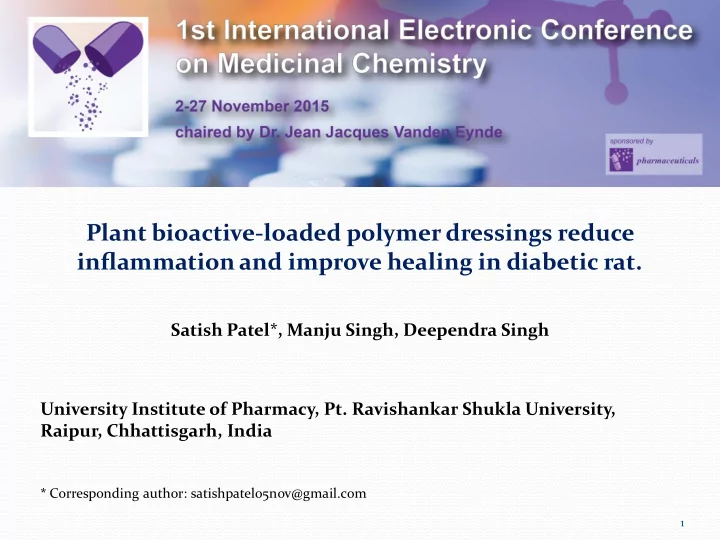

Plant bioactive-loaded polymer dressings reduce inflammation and improve healing in diabetic rat. Satish Patel*, Manju Singh, Deependra Singh University Institute of Pharmacy, Pt. Ravishankar Shukla University, Raipur, Chhattisgarh, India * Corresponding author: satishpatel05nov@gmail.com 1
Plant bioactive- loaded polymer dressings reduce inflammation and improve healing in diabetic rat. Graphical Abstract Lupeol Polymer Histological section of healed wound site Stages in wound healing Preparation and Optimization of delivery system Application on wound Healed wound site site 2
Abstract Impaired wound healing is an important clinical problem in diabetes and results in slow wound healing which may lead to infection, sepsis, gangrene and even amputations. In the present study, polymer (collagen and arginine) based dressings were prepared to be applied as scaffold for the control release of Lupeol (Lu), a triterpeniod that acts as an inflammatory modulator in wound healing. The activity of Lu – loaded polymer matrices to treat wounds in streptozotocin diabetic induced rat was evaluated. There was a delay in wound healing in diabetic rats as compared to non- diabetic rats. The dressing exhibited potent wound healing activity as indication by the wound contraction in the excision wound model. Lu – loaded polymer dressings make faster healing (21% wound area reduction) in the initial phase of wound healing in diabetic rat. Prepared system also significantly reduced inflammatory cytokine expression namely, TNF- α and IL-1 β and decreased the inflammatory infiltrate post- wounding. The contents of hydroxyproline and hexosamine also correlated with the observed healing pattern. These findings were supported by the histopathological characteristics of healed wound sections, as greater tissue regeneration, more fibroblasts, and angiogenesis were observed in the Lu – loaded polymer matrices-treated group. These results suggest that polymer-based dressings can be an effective support for Lupeol release into diabetic wound enhancing the healing process. Keyword: Wound healing, Diabetic wounds, Polymer based dressing 3
Introduction Worldwide, there are more than 350 million diabetic patients and about 20% of them suffer from diabetic wounds (DWs). The prevalence of this ranges from 4% to 10% with a lifetime incidence as high as 25% . In diabetic patients, a minor skin wound often leads to chronic, nonhealing ulcers and ultimately result in infection, gangrene, even amputation. DWs exhibit a persistent inflammatory phase associated with an impediment in the formation of mature granulation tissue and reduction in wound tensile strength. 4
MATERIALS AND METHODS Materials Lupeol (Sigma aldrich), Arginine (Himedia) Collagen(Sigma Aldrich) and Streptozotocin (Himedia). Preparation Arginine and chitosan hydrogel containing lupeol were prepared by freeze thaw method. Characterization Morphology and Particle size analysis Hydrogel were characterized by optical microscopy , SEM and water vapour transmission rate (WVTR). In vitro release studies in vitro release studies were conducted in triplicate and mean values and standard deviations were calculated. Diabetes induction Diabetes was induced by intraperitoneal injections of STZ (50mg/kg body weight), in citrate buffer pH 4.5, during 5 consecutive days . 5
Results and discussion Characterization of Arginine and collagen hydrogel SEM revealed the uniform dispersion of Lupeol in a three-dimensional lamellar matrix of the arginine and collagen hydrogel formulation. The WVTR of the hydrogel was found to be 1702 g/m2/day which is very close to the ideal value for wound dressing and indicating the suitability of film to be used as moisture retentive material as moist dressing In vitro release studies In-vitro release data showed that hydrogel showed a typical biphasic release pattern with burst release followed by sustained release. The burst release is mainly due to plant actives entrapped on the surface. The release rates were analysed by released model as first order model, higuchi model and ritger peppas model. 6
Results and discussion cont …. In vivo studies Signifiant positive differences (p < 0.01) between treated and control groups were observed at different aspects of diabetic wound healing process. Reduced inflammation and enhanced wound contraction, re-epithelialization, regeneration of granulation tissue, angiogenesis and collagen deposition were detected in the treated wounds. This was also supported by hydroxyproline and protein content. A linear increase in total protein content was observed in all groups including control . Table . Effect formulation on excision wound model Hydroxyproline Group Epithelization Time content (mg/gm) (Days) 21.00 ± 0.11 150.6 ± 2.69 I- animals treated with streptozotocin only 19.00 ± 0.776 162 ± 1.77 II- with prepared arginine and collagen hydrogel (without any drug) 18.80 ± 0.33 178 ± 1.55 III- animals treated topically with lupeol formulation (hydrogel containing pure drug) 16.01 ± 0.35 198.16 ± 0.33 IV- animals treated topically with ARG COL UR formulation (Multi phase hydrogel containing Drug) 7
Results and discussion cont …. Table: % wound contraction Group Day 3 Day 9 Day 18 11.12 ± 2.17 34.34 ± 0.93 55.54 ± 0.37 I- animals treated with streptozotocin only 13.11 ± 3.22 61.96 ± 0.21 79.76 ± 0.44 II- with prepared arginine and collagen hydrogel (without any drug) 12.13 ± 2.33 68.76 ± 0.36 88.39 ± 0.77 III- animals treated topically with lupeol formulation (hydrogel containing pure drug) 17.99 ± 3.12 80.01 ± 1.83 99.12 ± 0.88 IV- animals treated topically with ARG COL UR formulation (Multi phase hydrogel containing Drug) 8
Conclusions We concluded that Lu – loaded polymer dressings are effective as wound- healing accelerators in diabetic rat. Moreover, collagen and arginine stimulated tissue granulation, collagen expression and deposition at the wound site, which lead to the production of a more organized collagen matrix and angiogenesis as compared with lupeol alone. The promising results obtained in this work need also to be complemented with human studies to further investigate the potential application of wound dressings. 9
10
Recommend
More recommend